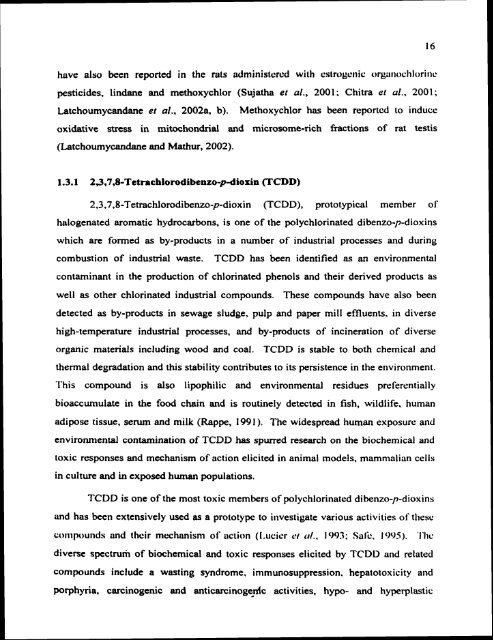ON TESTIS AND EPlDlDYMlS OF RATS - Pondicherry University ...
ON TESTIS AND EPlDlDYMlS OF RATS - Pondicherry University ...
ON TESTIS AND EPlDlDYMlS OF RATS - Pondicherry University ...
Create successful ePaper yourself
Turn your PDF publications into a flip-book with our unique Google optimized e-Paper software.
have also been reported in the rats administered with estrogenic organochlori~lc<br />
pesticides, lindane and methoxychlor (Sujatha e! a[., 2001: Chitra el al., 2001;<br />
Latchoumycandane et al., 2002a. b). Methoxychlor has been reported to induce<br />
oxidative stress in mitochondrial and microsome-rich fractions of rat testis<br />
(Latchoumycandane and Mathur, 2002).<br />
1.3.1 23,7,8-Tctmchlorodibenzo-pain (TCDD)<br />
2,3,7,8-Tetrachlorodibenzo-p-dioxin (TCDD), prototypical member of<br />
halogenated aromatic hydrocarbons, is one of the polychlorinated dibenzo-p-dioxins<br />
which arc formed as by-products in a number of industrial processes and during<br />
combustion of indusmal waste. TCDD has been identified as an environmental<br />
contaminant in the production of chlorinated phenols and their derived products as<br />
well as other chlorinated industrial compounds. These compounds have also been<br />
detected as by-products in sewage sludge, pulp and paper mill effluents. in diverse<br />
high-temperature industrial processes, and by-products of incineration of diverse<br />
organic materials including wood and coal. TCDD is stable to both chemical and<br />
thermal degradation and this stability contributes to its persistence in the environment.<br />
This compound is also lipophilic and environmental residues preferentially<br />
bioaccumulate in the food chain and is routinely detected in fish, wildlife. human<br />
adipose tissue, serum and milk (Rappe, 1991). The widespread human exposure and<br />
environmental contamination of TCDD has spurred research on the biochemical and<br />
toxic responses and mechanism of action elicited in animal models, mammalian cells<br />
in culture and in exposed human populations.<br />
TCDD is one of the most toxic members of polychlorinated dibenzo-p-dioxins<br />
and has been extensively used as a prototype to investigate various activities of thesc<br />
compounds and their m~rhanism 01' action (1.ucic.r o (11.. 1093; Sak. IOVS). I'hc<br />
diverse spectmm of biochemical and toxic responses elicited by TCDD and related<br />
compounds include a wasting syndrome. immunosuppression. hepatotoxicity and<br />
porphyria, carcinogenic and anticarcinoge-dc activities, hypo- and hyperplastic

















